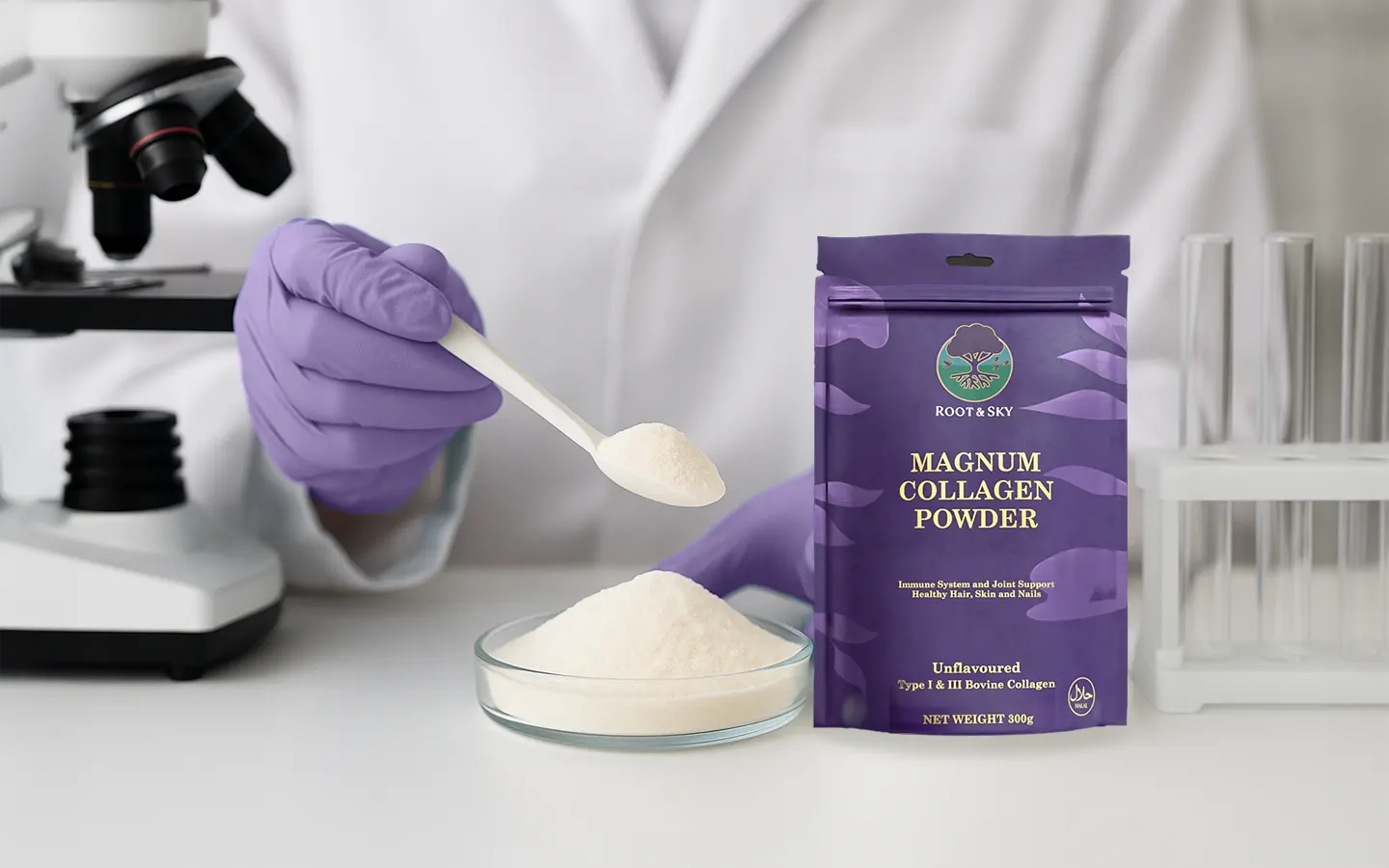Your basket is currently empty!
Collagen Supplements

What the Evidence Really Says (Skin, Joints, and Beyond)
21 Aug 2025. Educational information only; not medical advice.
Key points at a glance
- Collagen is the body’s most abundant protein and a structural component of skin, cartilage, bone, tendons and ligaments.
- Modern supplements typically use hydrolyzed collagen peptides (smaller fragments for easier absorption).
- Evidence is strongest for skin hydration and elasticity and joint comfort in some populations. Claims beyond these areas remain preliminary.
- Collagen is not a complete protein (it lacks tryptophan), so it complements—but does not replace—a balanced protein intake.
What collagen is—and the types you’ll see
Collagen is a family of proteins rich in the amino acids glycine, proline, and hydroxyproline. Type I predominates in skin, tendons, and bone; type II is common in cartilage; type III supports skin and blood vessels. Most bovine and marine supplements are type I (sometimes with III). Chicken sternum powders may emphasize type II for cartilage support.
Oral supplements are usually hydrolyzed (enzymatically broken down) into peptides. After ingestion, these peptides and amino acids appear in the bloodstream and can be incorporated into tissues. This doesn’t mean every claim is proven, but it makes the biology plausible.
Skin: hydration and elasticity
Several randomized controlled trials (RCTs) and meta-analyses report improvements in skin hydration, elasticity, and wrinkle depth after 4–12 weeks of daily collagen peptide intake (most commonly 2.5–10 g/day). A 2023 meta‑analysis in Nutrients concluded collagen peptides “may improve skin hydration, elasticity, and wrinkles” in the short to medium term in healthy women, especially when taken consistently for at least eight weeks. A 2025 meta‑analysis in The American Journal of Medicine reported modest improvements but also highlighted funding bias in the literature. Overall: beneficial effects are plausible and supported by multiple RCTs, yet magnitudes vary and high‑quality independent replications are still welcome.
How to read this: Look for products stating the daily peptide dose used in studies (often 2.5–10 g) and give them at least 8–12 weeks before judging results.
Joints and activity
Collagen (often type II or mixed peptides) has been studied for joint comfort in osteoarthritis and in physically active people. Reviews and RCTs show small‑to‑moderate symptom improvements for some individuals—e.g., reduced joint discomfort or stiffness scores—when taken daily for 3–6 months. Effects are not universal and tend to be modest; collagen is not a substitute for clinical care, strength training, or weight management, but it can be part of a broader plan.
Bones, hair, nails—what’s known
- Bone: Collagen contributes the organic matrix on which minerals like calcium and phosphorus deposit. Some small trials suggest collagen peptides may support bone turnover markers alongside calcium/vitamin D, but large fracture‑endpoint trials are lacking. Treat claims here as promising but preliminary.
- Hair & nails: Small studies and many anecdotes suggest reduced nail breakage and subjective hair benefits. Rigorous, independent RCTs are limited; set expectations accordingly.
Is collagen a good protein source?
Collagen’s amino acid profile is unusual: it is low in essential amino acids and lacks tryptophan, so it does not count as a complete protein. That doesn’t make it “bad”—glycine and proline are valuable—but it does mean you should not rely on collagen alone to meet daily protein needs. Combine it with complete proteins (e.g., dairy, eggs, legumes, soy, meat, fish) to cover essentials.
Dosing, timing, and forms
- Typical study doses: 2.5–10 g/day for skin; 5–10 g/day (or undenatured type II at much lower micro‑doses) for joints. More is not necessarily better.
- Timing: Daily consistency matters more than time of day. Many people add collagen to coffee or smoothies; peptides are generally heat‑stable at typical beverage temperatures.
- Forms: Bovine, marine, and chicken sources differ mainly in type composition and allergen considerations. Choose based on dietary preference and quality testing.
Bottom line
Collagen peptides are a reasonable, evidence‑supported option for skin hydration/elasticity and joint comfort for some people when taken daily for 2–3 months or more. They are not magic, and they don’t replace complete dietary protein—but as part of a well‑rounded routine, they can help.
References / Sources
Harvard T.H. Chan School of Public Health—Nutrition Source: Collagen. https://www.hsph.harvard.edu/nutritionsource/food-features/collagen/
Choi FD et al. Nutrients (2023): Systematic review/meta‑analysis of oral collagen for skin outcomes. https://www.mdpi.com/2072-6643/15/9/2100
Jeon YJ et al. Am J Med (2025): Meta‑analysis of collagen supplements for skin; notes funding bias. https://www.sciencedirect.com/science/article/pii/S0002934325000707
Clark KL et al. Curr Med Res Opin (2008): Collagen hydrolysate in athletes with activity‑related joint pain. https://pubmed.ncbi.nlm.nih.gov/18416885/
Zdzieblik D et al. Nutrients (2017): Collagen peptide supplementation and fat‑free mass after resistance training. https://www.mdpi.com/2072-6643/9/1/20
USDA AMS (2020): Gelatin/collagen lack tryptophan (incomplete protein). https://www.ams.usda.gov/sites/default/files/media/GelatinTR2020.pdf

Leave a Reply